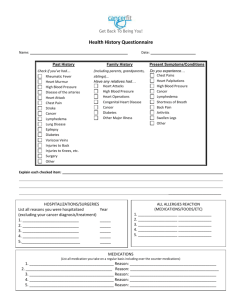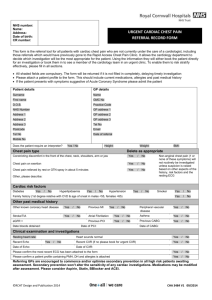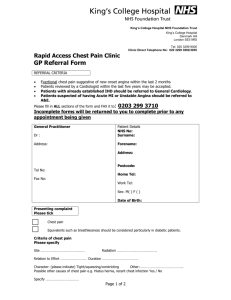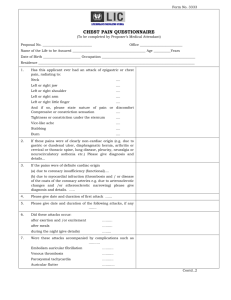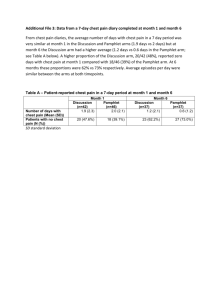Tbilisi State University, Faculty of Medicine Course: Case Based
advertisement
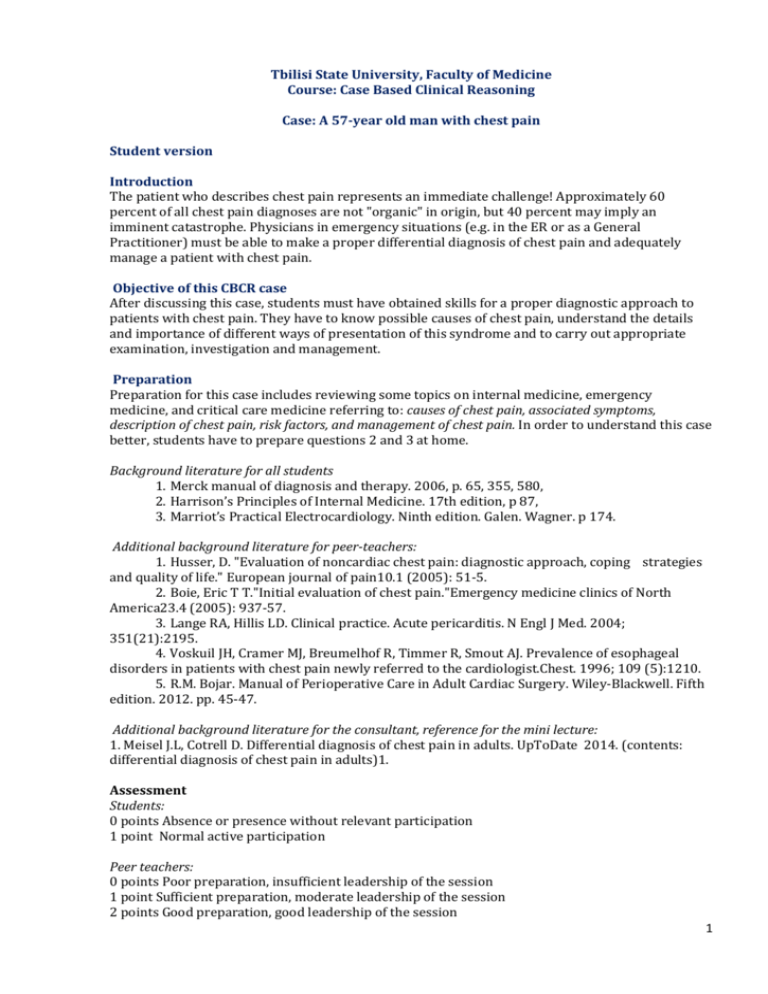
Tbilisi State University, Faculty of Medicine Course: Case Based Clinical Reasoning Case: A 57-year old man with chest pain Student version Introduction The patient who describes chest pain represents an immediate challenge! Approximately 60 percent of all chest pain diagnoses are not "organic" in origin, but 40 percent may imply an imminent catastrophe. Physicians in emergency situations (e.g. in the ER or as a General Practitioner) must be able to make a proper differential diagnosis of chest pain and adequately manage a patient with chest pain. Objective of this CBCR case After discussing this case, students must have obtained skills for a proper diagnostic approach to patients with chest pain. They have to know possible causes of chest pain, understand the details and importance of different ways of presentation of this syndrome and to carry out appropriate examination, investigation and management. Preparation Preparation for this case includes reviewing some topics on internal medicine, emergency medicine, and critical care medicine referring to: causes of chest pain, associated symptoms, description of chest pain, risk factors, and management of chest pain. In order to understand this case better, students have to prepare questions 2 and 3 at home. Background literature for all students 1. Merck manual of diagnosis and therapy. 2006, p. 65, 355, 580, 2. Harrison’s Principles of Internal Medicine. 17th edition, p 87, 3. Marriot’s Practical Electrocardiology. Ninth edition. Galen. Wagner. p 174. Additional background literature for peer-teachers: 1. Husser, D. "Evaluation of noncardiac chest pain: diagnostic approach, coping strategies and quality of life." European journal of pain10.1 (2005): 51-5. 2. Boie, Eric T T."Initial evaluation of chest pain."Emergency medicine clinics of North America23.4 (2005): 937-57. 3. Lange RA, Hillis LD. Clinical practice. Acute pericarditis. N Engl J Med. 2004; 351(21):2195. 4. Voskuil JH, Cramer MJ, Breumelhof R, Timmer R, Smout AJ. Prevalence of esophageal disorders in patients with chest pain newly referred to the cardiologist.Chest. 1996; 109 (5):1210. 5. R.M. Bojar. Manual of Perioperative Care in Adult Cardiac Surgery. Wiley-Blackwell. Fifth edition. 2012. pp. 45-47. Additional background literature for the consultant, reference for the mini lecture: 1. Meisel J.L, Cotrell D. Differential diagnosis of chest pain in adults. UpToDate 2014. (contents: differential diagnosis of chest pain in adults)1. Assessment Students: 0 points Absence or presence without relevant participation 1 point Normal active participation Peer teachers: 0 points Poor preparation, insufficient leadership of the session 1 point Sufficient preparation, moderate leadership of the session 2 points Good preparation, good leadership of the session 1 Estimated time schedule Case: 2 hrs (with 15 min break). Approximate time schedule per question: Question 1: 5 min Question 2: 10 min Question 3: 12 min Mini Lecture: 10 min Question 4: 10min Hand-out 1 Question 5: 10 min Question 6: 10 min Hand-out 2 Question 7: 15 min Hand-out 3 Question 8: 10 min Question 9: 5 min Question 10: 5 min Stage I – Presentation of the patient’s problem Case You are a physician at the ER. A 57-year-old man is admitted to the hospital with frontal pain in the chest wall, over the heart, as he describes. The pain is dull and localized behind the breastbone. It began acutely, with a feeling of “break up” (tearing) and has lasted for the last 2 days. He says that during this period he hasn’t felt comfortable and the intensity of the pain increases during inspiration and with body movement. Question 1. What is the main problem of the patient? Question 2. Provide a list of organ systems with their disorders that could be the cause of chest pain in this particular case, grouped in three categories (I -Likely, II-Less Likely, III – Not very Likely, but not excluded) Question 3. Agree upon all relevant hypotheses and discuss the mechanism how they can cause chest pain. Question 4. Which questions must be asked to discriminate between the most relevant hypotheses? Stage II - Results of history taking Hand-out 1 (Shown on the screen and read out loud) Question 5. List the five diagnostic hypotheses that are now most likely, and make a similar table as in the hand-out, but now for these five specific diseases Question 6. Which components of the physical examination will you perform? Stage III - Results of physical examination 2 Hand-out 2 (shown on the screen and read out loud) Question 7. Which next investigations are needed to come to a conclusion? Stage IV - Results of diagnostic tests Hand-out 3 (shown on the screen and read out loud) Question 8. What can be concluded from the results and what final investigation should be done for the diagnosis? Question 9. Suggest a treatment and estimate a prognosis. Question 10. One of the students summarizes the whole case chronologically in a few minutes +++ 3


